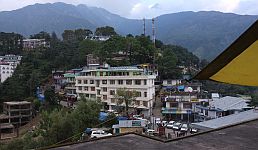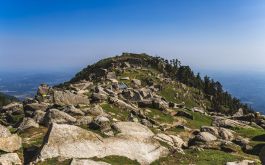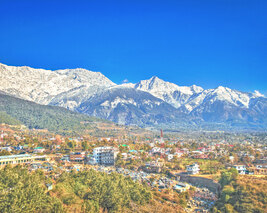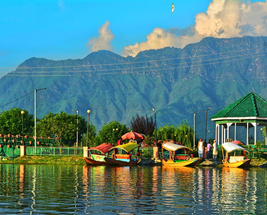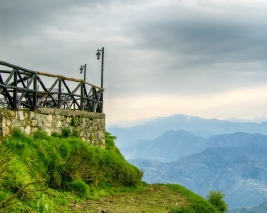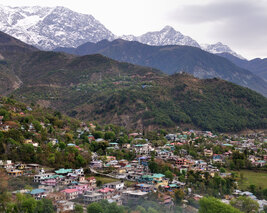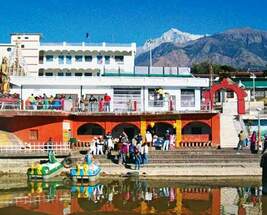Home to the world’s most peace loving individual, the Dalai Lama, it’s no surprise that travellers are drawn to this mountainous paradise. Nestled in the northern state of Himachal Pradesh, Dharamshala is a place of immense beauty, spirituality, history, culture and recreation. A former British summer resort, it has centuries of experience in serving individuals with the finest of offerings. Currently a major tourist destination, it continues to please its guests with a heady blend of nature and entertainment. From religion to art, cuisine, sports and shopping, the city culminates into one enriching vacation spot!
When it comes to the climate, Dharamshala follows that of any other hilly terrain in the Himalayan mountain ranges. Its winters are piercing, its summers are mild and its monsoons are variable. And, with each period comes unique and unparalleled beauty attached to it. As such, when it comes to the best time to visit Dharamshala, one must delve deeper into each season.
Thomas Cook has done just this! Read further for a concise break up of each of the region’s pronounced seasons and all that comes with it.
Peak Season – March to June
Shoulder Season – December to February
Low Season – July to September
|
Travel Seasons
|
Min/Max Temperature
|
Season
|
|
March to June
|
20-35°C
|
Summer - Pleasant
|
|
July to September
|
18-22°C
|
Monsoon -High rainfall
|
|
December to February
|
4-7°C
|
Winter - Freezing
|
Dharamshala in Summer (March to June)
Temperature – The air temperature during the season of summer fluctuates between 20°C and 35°C.
Weather – The weather of Dharamshala during summer is perfectly pleasant. The sun shines with contentment and the flowers bloom joyfully. The climate is comfortable and the atmosphere is pleasing. In-fact, this is the best climate to visit Dharamshala for trekking and sightseeing!
Significance – The season of summer is the most delightful time to sightsee, wander and navigate this former British colony. From quaint colonial bungalows to beautiful churches and monasteries, colourful bazaars, fascinating art museums and rejuvenating Yoga institutes, Dharamshala is filled with exquisite places to traverse. And, let’s not forget the adrenaline pumping adventure sports!
Why you should visit now – If you’re seeking adventure and thrills, this season is yours for the taking. From trekking to paragliding, zip lining, rappelling, camping and cable car riding, Dharamshala offers an exciting itinerary of activities. Some of these may not be operable during winter and definitely not during monsoon, so take this into consideration when identifying your best time to visit.
Things to know before the visit – This is peak tourist season for obvious reasons. Hence, accommodation will be more expensive, sightseeing queues will be longer and guided tours may be booked out. Weekends are a particularly crowded time. Make sure to plan well in advance as this season welcomes throngs of travellers.
Tips – Due to the elevation of this city, the sun’s rays are direct and can be harsh. Make sure you strap on some sunscreen and throw on a hat! Keep your clothing light and airy, but make sure they include long sleeve t shirts and pants. Always carry a cardigan, just in case it gets chilly.
Dharamshala in Monsoon (July to September)
Temperature – The air temperature during the season of monsoon fluctuates between 18°C and 22°C.
Weather – Dharamshala during monsoon is a rainy-romantic affair! The showers rejuvenate the surroundings, rending everything green and lush. While days are humid, evenings are a particularly lovely time to enjoy the cool breeze. Rainfall is high and can be particularly unforgiving if not dealt with properly.
Significance – Just because it’s raining cats and dogs outside, doesn’t mean there’s nothing to do inside. Dharamshala’s resorts offer a unique blend of activities and facilities for a relaxed and fun holiday. What’s more? You can visit the charming cafes and book stores during this time. If the weather permits, there are scenic walking/driving routes and panoramic viewing points for you to enjoy.
Why you should visit now – The monsoon season can be a great time to go café hopping and initiate good conversation with fellow travellers. What better way to have unique experiences? Share a cup of steaming chai with someone from another country, as the rain creates its own symphony outside. Enjoy what the sparkling water does to the emerald surroundings, it is genuinely magnificent!
Things to know before the visit – The monsoon season brings with it, certain risks. Heavy rainfall can lead to landslides, road blockages and loss of communication. As such, adventure sports are not permitted nor recommended during this time. The precarious nature of this period renders it an off season, due to which travel and accommodation may be more affordable.
Tips – Pack an umbrella, windcheater and sturdy rain shoes such as gumboots. Plan your day according to the weather forecast, so that you can take advantage of periods of drizzles. Do not attempt to navigate the roads by yourself.
From mid-September to November, the rainfall diminishes to an inevitable halt. This period marks the confluence of the monsoon and winter season. During this beautiful passage, the climate is cool and pleasant. However, nights drop to bitter-biting degrees!
Dharamshala in Winter (December to February)
Temperature – The air temperature during the season of winter fluctuates between 4°C and 7°C.
Weather – Like other cities in the Indian state of Himachal Pradesh, Dharamshala experiences bitter biting winters. With temperatures landing the minus scale, the atmosphere is coated in thick layers of frost and fog. Strong gusts of winds add to the chill in the air. The landscape is blanketed in glistening snow, magic to the naked eye.
Significance – The season of winter is ripe for exploration and wanderlust – with the backdrop of the snowy mountains and crystalline waterfalls. One can visit McLeod Ganj, a suburb in Dharamshala, which is ideal for nature and culture enthusiasts. Shops, cafes and farms lend an air of authenticity and warmth. Lakes, valleys and trails create the most stunning setting for backpackers.
Why you should visit now – Winter is the best season to visit Dharamshala, if you’re looking to cosy up and enjoy some of its most gorgeous resorts. With indoor activities galore and sightseeing tours, you will have the opportunity to experience the best of both worlds. And, if you’re brave enough, this is the time to engage in some thrilling winter sports such as skiing.
Things to know before the visit – All hotels will offer electric heating and hot water facilities, but make sure you triple check. As this is mid-season, travel and accommodation prices will fall somewhere in between. With that being said, tourists still flock to the city to enjoy the snow and slate!
Tips – Make sure you’re geared up for the freezing climate. Which means having woollen sweaters, scarves, mufflers, a proper winter jacket, socks and snow boots. Invest in some thermals too! Carry protective inner wear such as vests, to keep your chest warm. Moisturiser and lip balm will be your best friends during this time!
Are you ready to experience the glory of this fine hilly haven? Sift through Thomas Cook’s Dharamshala tour packages to begin your holiday planning!










